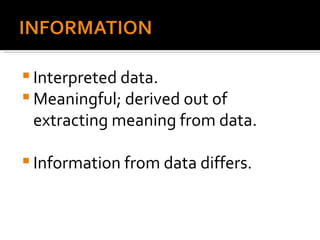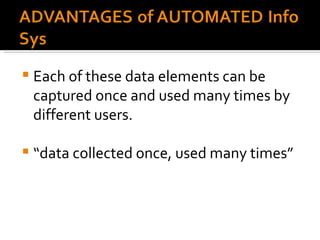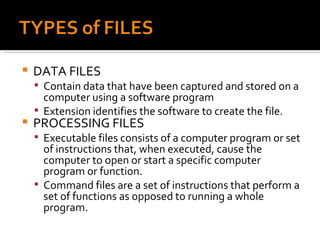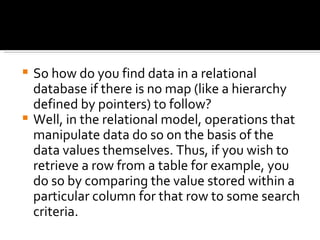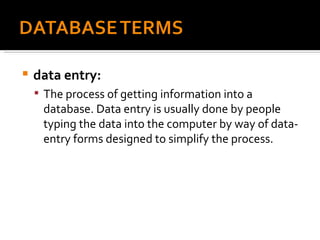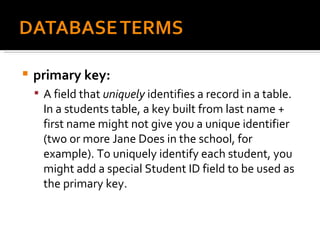Data processing
- 2. Are raw uninterrupted facts that are without meaning.
- 3. Interpreted data. Meaningful; derived out of extracting meaning from data. Information from data differs.
- 4. An organized collection of related data/information. Size of database is determined not only by the amount of data but also by the number and complexity of relationships between data.
- 5. Are used to process data and produce information The MOST effective and complex information system is the HUMAN BRAIN.
- 6. CONCEPTUAL DATA TYPES Reflects how user’s view the data, how data will be used, based on source or an event that the data are attempting to capture Ex. Financial data, patient data, or human resource data Impacts on how data will be indexed
- 7. COMPUTER-BASED DATA TYPES Can be letters or numbers or combination of both ALPHANUMERIC data Letters and numbers in any combination; cannot perform numeric function; e.g. address, SS number NUMERIC data Used to perform adding, subtracting, multiplying and dividing; formats options include commas and digits after decimal; can be long integer, currency, or scientific LOGIC data Data limited to two (2) options Ex. YES or NO, TRUE or FALSE, 1 or 2, ON or OFF.
- 8. Each of these data elements can be captured once and used many times by different users. “ data collected once, used many times”
- 9. Are computer programs used to input, store, modify, process and access data in a database. DATABASE SYSTEM DESIGN- process of configuring database software. Once configured, database software is used to enter project data into the computer.
- 10. 1. Configured software program 2. DATA 3. Query Language – used to access data
- 11. Decrease data redundancy Increase data consistency Improve access to all data
- 13. DATA FILES Contain data that have been captured and stored on a computer using a software program Extension identifies the software to create the file. PROCESSING FILES Executable files consists of a computer program or set of instructions that, when executed, cause the computer to open or start a specific computer program or function. Command files are a set of instructions that perform a set of functions as opposed to running a whole program.
- 14. CONCEPTUAL MODELS Defines the structure of the whole data base in terms of the attributes of the entities (data elements) relationships, constraints, and operation Includes a diagram and narrative description One-one relationship One-to-many relationship Many-to-many relationship
- 15. STRUCTURAL or PHYSICAL DATA MODELS Includes each of the data elements and the relationships between the data elements as they will be stored in a computer. Hierarchical database Network Model Relational Database Models Object-oriented Model Client –server Model
- 16. This is quite a bit different from the hierarchical and network models in which the user had to have an understanding of how the data was structured within the database in order to retrieve, insert, update, or delete records from the database.
- 17. So how do you find data in a relational database if there is no map (like a hierarchy defined by pointers) to follow? Well, in the relational model, operations that manipulate data do so on the basis of the data values themselves. Thus, if you wish to retrieve a row from a table for example, you do so by comparing the value stored within a particular column for that row to some search criteria.
- 18. database: A collection of related information stored in a structured format. The term ‘database’ is sometimes used interchangeably with ‘table’, but technically they’re different: a table is a single store of related information; a database, on the other hand, may consist of one or more tables of information that are related in some way. For instance, you could track all the information about students in a school in a students table. If you then created separate tables containing details about teachers, classes and classrooms, you could combine all four tables into a timetabling database. Such a multi-table database is called a relational database .
- 19. For instance, you could track all the information about students in a school in a students table. If you then created separate tables containing details about teachers, classes and classrooms, you could combine all four tables into a timetabling database. Such a multi-table database is called a relational database .
- 20. data entry: The process of getting information into a database. Data entry is usually done by people typing the data into the computer by way of data-entry forms designed to simplify the process.
- 21. dbms: Database management system. A program which lets you manage information in databases. Alpha 5, Microsoft Access and FileMaker Pro, for example, are all DBMSs, although the term is often shortened to ‘database’. So, the same term is used to apply to the program you use to organise your data and the actual data structure you create with that program.
- 22. field: Fields describe a single aspect of each member of a table . A student record , for instance, might contain a last name field, a first name field, a date of birth field and so on. Each record in a table has exactly the same structure, so each contains the same fields. While the field structure is the same, the values in each field vary from record to record, of course.
- 23. flat file: A database that consists of a single table. Lightweight database programs such as the database component in Microsoft Works are sometimes called ‘flat-file managers’ (or list managers) because they can only handle single-table databases. More powerful programs, such as Access, FileMaker Pro and Alpha 5, can handle multi-table databases, and are called relational database managers, or RDBMSs.
- 24. index: A summary table which lets you quickly locate a particular record or group of records in a table. Think of how you use an index in a book: as a quick jumping off point for finding full information about a subject. A database index works in a similar way. You can create an index on any field in a table. Say, for example, you have a customer table which contains customer numbers, names, addresses and other details. You can make indexes based on any information, such as the customer number,the last name + first name (a composite index based on more than one field), or the postal code. Then, when you’re searching for a particular customer or group of customers, you can use the index to speed up the search.
- 25. key field: You can sort and quickly retrieve information from a database by choosing one or more fields to act as keys. For instance, in a students table you could use a combination of the last name and first name fields as a key field. The database program will create an index containing just the key field contents. Using the index, you can quickly find any record by typing in the student’s name. The database will locate the correct entry in the index and then display the full record containing all the student’s details.
- 26. primary key: A field that uniquely identifies a record in a table. In a students table, a key built from last name + first name might not give you a unique identifier (two or more Jane Does in the school, for example). To uniquely identify each student, you might add a special Student ID field to be used as the primary key.
- 27. record: A record contains all the information about a single ‘member’ of a table. In our students table, each student’s details (name, date of birth, contact details, and so on) will be contained in its own record.
- 28. relational database: A database consisting of more than one table. In a multi-table database, you not only need to define the structure of each table, you also need to define the relationships between each table in order to link those tables correctly.
- 29. table: A single store of related information. A table consists of records, and each record is made up of a number of fields. You can think of the phone book as a table: It contains a record for each telephone subscriber, and each subscriber’s details are contained in three fields – name, address and telephone.
- 35. Although your ultimate design will depend on the complexity of your data, each time you design a database, make sure you do the following: Break composite fields down into constituent parts. Example: Name becomes lastname and firstname. Create a key field which uniquely identifies each record. You may need to create an ID field (with a lookup table that shows you the values for each ID) or use a composite key.
- 36. Eliminate repeating groups of fields. Example: If your table contains fields Location 1, Location 2, Location 3 containing similar data, it's a sure warning sign. Eliminate record modification problems (such as redundant or inconsistent data) and record deletion and addition problems by ensuring each non-key field depends on the entire key. To do this, create a separate table for any information that is used in multiple records, and then use a key to link these tables to one another.


